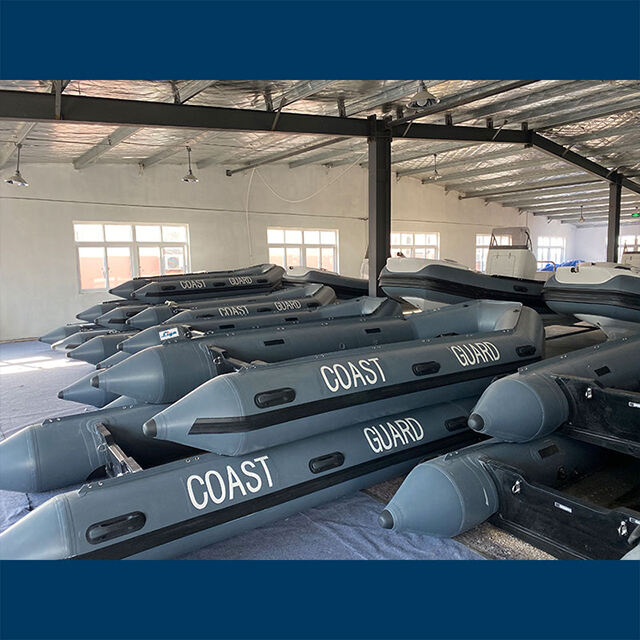Merilainsäädännön valvonta: Meripoliisiyksiköiden keskeinen rooli
Merilainsäädännön valvonnalla on keskeinen rooli turvallisuuden ja järjestyksen ylläpitämisessä vesireiteillämme. Poliisiveneet toimivat merirajojemme, satamiemme ja rannikkovesiemme eturintamassa, varustettuina edistyneellä teknologialla ja niissä toimii erittäin koulutettuja virkamiehiä, jotka työskentelevät ahkerasti meren ympäröimän elämän ja omaisuuden suojelemiseksi. Nämä erikoistuneet alukset mahdollistavat lainsuojan toteuttajien nopean reagoinnin hätätilanteisiin, rikollisuuden ehkäisyn ja merilainsäädännön noudattamisen varmistamisen.
Liikennepaikoista syrjäisille rannikkoihin asti poliisiveneet pitävät veden päällä jatkuvasti läsnäoloaan toimien sekä pelottavana että pelastusvoimana. Niiden kyvyt menevät paljon pidemmälle kuin perinteisten maaperällä toimivien yksiköiden, mikä mahdollistaa meriympäristön aiheuttamien ainutlaatuisten haasteiden käsittelyn. Merilainsäädännön valvonnan kehittyminen on johtanut yhä kehittyneempiin aluksiin ja varusteisiin, joiden ansiosta virkamiehet voivat suorittaa tehtäviään tehokkaammin kuin koskaan aiemmin.
Meripoliisiyksiköiden keskeiset tehtävät ja ominaisuudet
Hakeminen ja pelastustoimet
Yksi tärkeimmistä poliisiveneiden tehtävistä on etsintä- ja pelastustoimet. Nämä alukset ovat usein ensimmäisiä vastaajia, kun harrastelumerenkulkijat kohtaavat hätätilanteita, olipa kyseessä mekaaninen vika tai lääketieteellinen kriisi. Merialukot on varustettu edistyneillä navigaatiojärjestelmillä, lämpökameroinnilla ja lääkintävarusteilla nopeuttaakseen vaarassa olevien alusten sijainnin selvittämistä ja niiden miehistön auttamista.
Pelastusoperaatioiden onnistuminen riippuu paljolti poliisiveneiden nopeudesta ja ketteryydestä. Nykyaikaiset alukset on varustettu tehokkailla moottoreilla ja runomuotoisilla rattoilla, jotka mahdollistavat tehokkaan toiminnan myrskyisissä meriolosuhteissa ja epäsuotuisissa sääoloissa. Lisäksi ne kuljettavat erikoislaitteita, kuten pelastusveneitä, heitto-ohjaimia ja hätälääketarvikkeita, jotta voidaan tarjota välitön apu tarvitseville.
Rikollisuuden ehkäisy ja valvonta
Poliisiveneillä on keskeinen rooli vesillä tapahtuvan rikollisuuden ehkäisyssä ja torjunnassa. Huumausainerikoksista laittomaan kalastukseen meriyksiköt suorittavat säännöllisiä tarkastuskäyntejä lain ja järjestyksen ylläpitämiseksi. Nämä alukset on varustettu kehittyneellä valvontalaitteistolla, kuten tutkajärjestelmillä ja yö näkyvyysominaisuuksilla, mikä mahdollistaa viranomaisten tehokkaan valvonnan epäilyttäviä toimintoja.
Poliisiviranomaiset käyttävät poliisiveneitä suorittaakseen laivastusoperaatioita, tarkistaakseen alusten noudattamista turvallisuussääntöjä ja tutkiakseen mahdollisia rikollisia toimia. Näiden patruunaveneiden läsnäolo toimii voimakkana pelotteena, joka auttaa estämään laittomia toimia ennen niiden tapahtumista. Virkamiehet on koulutettu merioikeuteen ja laivastusmenettelyihin, mikä varmistaa erilaisten tilanteiden asianmukaisen käsittelyn.

Kehittynyt teknologia ja laitteet
Navigointi- ja viestintäjärjestelmät
Modernit poliisiveneet on varustettu huippuluokan navigointi- ja viestintätekniikalla. GPS-järjestelmät, elektroniset kartat ja edistyneet tutkalaitteet mahdollistavat tarkan navigoinnin ja tilannetietoisuuden. Nämä alukset käyttävät myös useita viestintäkanavia, mukaan lukien merenkulun VHF-radio, satelliittiviestintä ja integroidut tietokonejärjestelmät, jotka yhdistävät ne rannalla sijaitseviin komentokeskuksiin.
Reaaliaikainen datan jakaminen mahdollistaa meriyksiköiden tehokkaan yhteistyön muiden lainvalvontaviranomaisten ja hätäpalvelujen kanssa. Tämä teknologinen integraatio varmistaa, että poliisiveneet voivat pitää yhteyttä jatkuvasti ja saada päivitettyjä tietoja kehittyneistä tilanteista, sääoloista ja mahdollisista uhista.
Valvonta- ja havaintolaitteet
Poliisiveneet käyttävät huippuunsa kehitettyä valvontatekniikkaa meriliikenteen seurantaan. Korkearesoluutioiset kamerat, lämpökuvajärjestelmät ja edistyneet tutkalaitteet mahdollistavat mielenkiinnon kohteena olevien alusten havaitsemisen ja jäljittämisen myös vaikeissa olosuhteissa tai pimeän aikana. Nämä välineet ovat välttämättömiä mahdollisten turvallisuusriskien tunnistamisessa ja onnistuneiden etsintätoimien suorittamisessa.
Moniin poliisiveneisiin on asennettu myös kyky tunnistaa vesiallareita, mikä mahdollistaa upotettujen esineiden tai alusten paikantamisen. Tämä teknologia on erittäin arvokasta etsintä- ja pelastustoimissa sekä navigointia haittaavien tekijöiden tunnistamisessa. Tekoäly- ja koneoppimisjärjestelmien integrointi parantaa entisestään näiden valvontatyökalujen tehokkuutta.
Koulutus ja toimintamenettelyt
Viranomaisen pätevyys ja sertifiointi
Meripoliisit suorittavat kattavaa koulutusta poliisiveneiden tehokkaaseen ja turvalliseen käyttöön. Koulutukseen kuuluvat navigointitaidot, hätätilojen toimintamenettelyt ja meriympäristöön erityisesti soveltuvat lainvalvontastrategiat. Viranomaisten on saatava useita todistuksia ja lupia, joilla he osoittavat osaamisensa veneen kuljettamisessa, pelastustoimissa ja merilainvalvonnassa.
Jatkuva koulutus varmistaa, että virkamiehet pysyvät taitavina uusimman laitteiston käytössä ja ovat ajan tasalla kehittyvistä meriturvallisuushaasteista. Tähän kuuluvat säännölliset harjoitukset ja toimintaharjoitukset, joilla varmistetaan valmius erilaisiin tilanteisiin, alkaen tavallisista patrouilleista monimutkaisiin hätätoimenpiteisiin.
Standardi käyttömenettelyt
Poliisiveneet toimivat tiukkojen protokollien ja menettelyjen mukaisesti, joiden tarkoituksena on turvallisuuden ja toiminnallisen tehokkuuden varmistaminen. Nämä menettelyt kattavat kaiken arkipäiväisistä aluksen tarkastuksista hätätilaprotokolliin asti. Selkeät ohjeet ovat olemassa patrouilloinnin suorittamiseen, epäilyttävien alusten lähestymiseen sekä muiden virastojen kanssa yhteistoiminnassa operoitaessa.
Riskinarviointi ja -hallinta ovat meripoliisin toiminnan keskeisiä osia. Virkailijoiden on jatkuvasti arvioitava sääolosuhteita, alusliikennettä ja mahdollisia uhkia tehdäkseen perusteltuja päätöksiä toiminnastaan. Näiden menettelyjen avulla voidaan taata sekä lainvalvojien että heidän palvelemaansa yleisöä koskeva turvallisuus.
Usein kysytyt kysymykset
Mitä erityisominaisuuksia poliisiveneillä on verrattuna tavallisiin aluksiin?
Poliisiveneet on varustettu erikoistuneilla ominaisuuksilla, kuten tehokkailla moottoreilla kiinnipitämisjärjestelmiä varten, edistyneillä navigointi- ja viestintäjärjestelmillä, valvontalaitteilla ja lääketieteellisillä tiloilla. Niissä on myös vahvistetut rungot, erikoistuneet valojärjestelmät ja omat alueet lainvalvontatoimintojen suorittamiseen.
Miten poliisiveneet koordinoivat muiden hätäpalvelujen kanssa?
Meripelastusyksiköt ylläpitävät jatkuvaa viestintää muiden hätäpalvelujen kanssa integroidujen viestintäjärjestelmien kautta. Ne tekevät tiivistä yhteistyötä rannikkovartioston yksiköiden, palokuntien ja ensihoidon kanssa yhteisten komentokeskusten kautta, mikä varmistaa saumattoman yhteistyön monimutkaisissa operaatioissa.
Mihin tyyppisiin hätätilanteisiin poliisiveneet useimmiten reagoivat?
Poliisiveneet vastaavat yleensä erilaisiin merionnettomuuksiin, kuten etsintä- ja pelastustoimiin, siviilialusten mekaanisiin vikoihin, merellä sattuviin sairaalilöikiin, veneilyonnettomuuksiin sekä epäilyttävistä toimista tehtyihin ilmoituksiin. Ne osallistuvat myös säännöllisesti ympäristönsuojelutoimiin ja valvovat meriliikenteen turvallisuusmääräyksien noudattamista.

